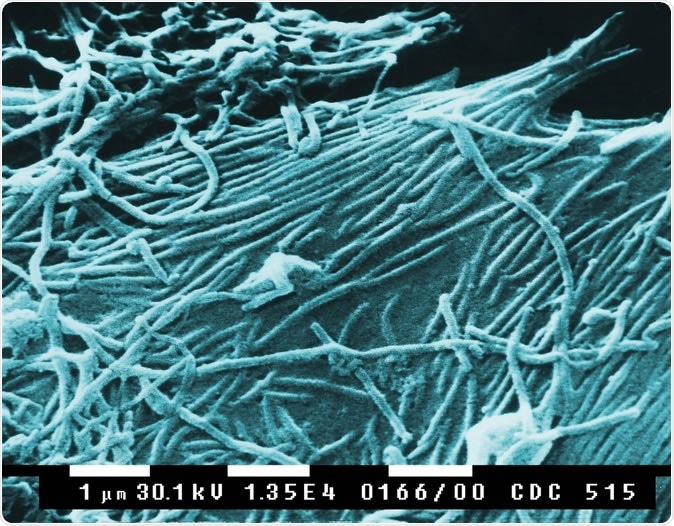A second experimental Ebola vaccine made by Johnson & Johnson will soon undergo clinical trials in the Ebola affected Democratic Republic of the Congo (DRC) announced health officials. The second round of vaccinations is to begin middle of October this year.

Ebola virions (virus particles). Ebola hemorrhagic fever is a severe, often-fatal disease Image Credit: Everett Historical / Shutterstock
According to experts this vaccine has a schedule of 2 doses to be administered 56 days apart. The vaccine is particularly targeted towards population living in regions where there is a greater risk of Ebola transmission says the World Health Organization (WHO) report.
WHO Director-General, Dr Tedros Adhanom Ghebreyesus, in a statement said, “The DRC authorities, in deciding to deploy the second experimental vaccine to extend protection against this deadly virus, have once again shown leadership and their determination to end this outbreak as soon as possible.” Dr Matshidiso Moeti, WHO’s Regional Director for Africa added, “The evaluation of the second Ebola vaccine will help ensure that we have potentially an additional tool to prevent the expansion of the outbreak and also a potential tool to protect populations before outbreaks hit areas at risk.”
At present a vaccine called the rVSV-ZEBOV-GP, manufactured by Merck has undergone clinical trials and so far has shown promising results. It is safe and effective say the health officials and has successfully prevented thousands of cases of Ebola in the affected regions of DRC. The vaccine from Merck would still be used among the population of DRC, the WHO report said. Persons who have been in contact with another with Ebola would be administered the Merck vaccine. The report added that during this present outbreak of Ebola this vaccine has been administered to 223,000 individuals who have been in contact with someone with Ebola or have been contacts of these contacts.
The last recommendations of Ebola vaccine came from WHO’s Strategic Advisory Group of Experts on Immunization (SAGE) in May 2019 where the dose of Merck vaccine was adjusted. SAGE advised about the protocols to be followed for clinical trials of the second vaccine as well. In addition SAGE oversaw the vaccine stations and kiosks that vaccinated who villages that were at risk of Ebola transmission.
Tedros added, “In everything we do, we are driven by science. The advice we were given by SAGE in May has been applied, always taking into account community needs and preferences, as we know this will make the approach more effective. The changes made have saved thousands of lives in this outbreak.” Dr Moeti said, “To date, 973 people have been successfully treated and released from Ebola treatment centres, and we expect that the 1,000th survivor will return to his or her community in the coming weeks.”
The SAGE had recommended a “ring strategy” for vaccinations. This meant that all persons who have come into contact with a person with Ebola would be vaccinated against the disease using rVSV-ZEBOV-GP vaccine. SAGE recommended that in regions which are war torn or disturbed or if there are any stigma preventing healthy contacts of Ebola victims from getting vaccinated, the vaccination centres must be taken to the populations. In other workd temporary vaccine stations or kiosks were set up as health posts. These were set up close to a person infected with Ebola. This allowed the contacts of the patient to come and get vaccinated anonymously says the WHO press release.
SAGE recommended another vaccination strategy called the “targeted geographic vaccination”. In this technique all the persons residing in the neighbourhood or village of an infected person need to be vaccinated rather than vaccinating only the contacts of the infected person. This strategy was adopted when there was an Ebola outbreak in Chowe in South Kivu. There was a 90 percent acceptance of the vaccine during this outbreak says WHO.
The HO says that at present the ring vaccinators are mostly healthcare workers, trained doctors as well as medical students belonging to the affected communities who can speak the local language and also empathize with the local concerns.
The WHO is working towards ensuring that both ring vaccinators and targeted geographic vaccinators have access to a minimum supply of 10,000 doses and are constantly monitoring the supplies of the vaccines. Merck has supplied 245,000 doses of their vaccine for DRC and there is a present stock of 190,000 doses to be sent to DRC says WHO. Over the next six to eighteen months Merck would replenish the stocks with 650,000 doses of the vaccines. The SAGE recommends 390,000 doses to be available and 1.3 million doses to be at hand for use.
Dr Tedros said, “The Merck vaccine is highly efficacious, and we’ll soon have a second vaccine to increase the number of those being protected against the virus. But vaccine and therapeutics are only some of the tools -- the key to ending the outbreak is community ownership. With the communities fully engaged, and with all partners stepping up and rallying behind our common goal, we can and will end this outbreak.”